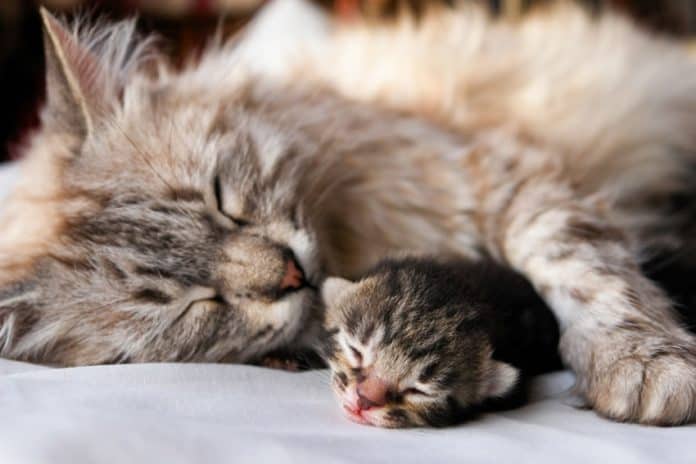Queening or the act of delivering kittens is normally a natural process for cats, yet there are some occasions when a normal birth is tough. Abnormal or difficult birth, also known as dystocia in cats is a common problem in the veterinary medicine. If your feline is about to deliver a litter of kittens, you need to acquaint yourself with the normal process of birth. Else, it might be hard to determine when and if there’s a problem existing. In this article, we will discuss some more important facts about dystocia in cats including its causes, symptoms, prognosis, and treatments. Read on to learn more about these!
What is Dystocia in Cats?

Difficulty in giving birth or dystocia is a difficult experience that a queen may suffer from. This may occur due to fetal or maternal factors, and it may happen during whatever stage of the queen’s labor. Abnormalities of position, posture, and presentation of the fetus in the uterus of the cat may affect negatively the temporal relationship in between the maternal birth canal and the birthing offspring.
Additionally, the uterine inertia or inactivity might be secondary or primary. The latter one is symptomized through a failure of the body in commencing the synchronous uterine contractions. While the former one is symptomized by the cessation of the uterine contractions because of the uterine fatigue. This one may occasionally happen when the labor has went on much longer than the capacity of the uterine muscles in meeting the demands.
There are actually three stages of cat’s labor. Moreover, the first one entails the beginning of the uterine contractions, rupture of chorioallontoic sac, and the relaxation of the cervix. In addition, the cat may purr and hang out throughout the first stage. The purring itself is believed to be a technique of self-relaxation.
The second of the stages is when the fetuses are being pushed out via uterine contractions. In cats, the average extent of the full parturition is 16 hours, having a range of about 4 to 42 hours. It’s common to consider this particular variability before superseding.
The third and final stage is the delivery of fetal membrane. The queen might alternate in between stage 2 & 3 with numerous fetuses delivered. It might deliver1 or 2 fetuses trailed by 1 or 2 fetal membranes or it might deliver the fetus following its associated fetal membrane.
Causes
Maternal Causes
- Uterine cancer, adhesions, or cysts
- Uterine torsion and / or rupture
- Lack of sufficient lubrication
- Insufficient dilation of the cervix
- Abnormality of cat’s vulvar opening
- Abnormality of cat’s vaginal vault
- Congenitally small pelvis
- Abnormal pelvic canal due to different causes
- Pregnancy toxemia and gestational diabetes
- Inflammation of the uterus
- Ineffective abdominal press
- Poor uterine contractions
Fetal
- Fetal death
- Abnormal position, posture, and presentation of the fetus in birth canal
- Oversize fetus
Biasing Factors to Dystocia
- Preceding history of dystocia
- Sudden changes in the environment before the cat goes through labor
- Obesity
- Himalayan or Persian breeds
- Brachycephalic and toy breeds
- Age
Symptoms
- Absent or diminished Ferguson reflex
- Presence of bloody discharge prior the delivery of the first kitten or in between fetuses
- Prolonged gestation
- Female cries, showing signs of pain, and constant licking in the vulvar area when contracting
- Failure in commencing labor inside the 24 hour drop in the rectal temperature
- Above 2 hours of interval in between the delivery of fetuses
- More than 4 hours from the stage 2 onset to the delivery of the first fetus
- More than 30 minutes of abdominal, strong, persistent contractions, even with no expulsion of an offspring
Prognosis
Veterinarians may pay attention to the following history and situations.
- Prior births
- Pelvic trauma
- Odd discharge from vulva before the fetuses are born
- Apparent pain of the queen –howling, gnawing or licking at the vulva
- Pause in the labor that lasts more than 4-6 hours
- No kitten is born when the queen experiences austere abdominal contractions, which last for above 2 hours
- Birth does not occur in at least 24 hours when the rectal temperature drops through 37.7 degrees Celsius or 100 degrees Fahrenheit
- Previous history of reproductive tract blockage or dystocia
The veterinarian might also conduct a sterile digital examination, in order to determine the degree of the obstruction in the cat’s birth canal, even the presentation, as well as the position of the fetuses. In order to determine the presence, location, health, and mass of the fetuses, the vet may also conduct ultrasound or radiography scans.
Treatments for Dystocia in Cats
Medication –the source of some kinds of uterine inertia is due to a lack of calcium or oxytocin or both. In order to stimulate stronger contractions, the vet might inject oxytocin, as well as calcium gluconate. There’s danger linked with this kind of injections, in that the uterus may rupture.
Cesarean section –if dystocia may not get resolved by using medications, the vet might determine whether a cesarean section is needed. Furthermore, the vet may decide if this procedure that’s used when all kinds of birthing problems are actually present, is the best choice for the queen. The vet might take into consideration the following:

- Lack of response to oxytocin
- Dry vaginal canal
- The size of kitten relative to the uterus of the queen
- Testing and x-ray results
- The queen’s condition
- The length of labor
Most cases present no problems at all, more especially when the queen is healthy and young.









